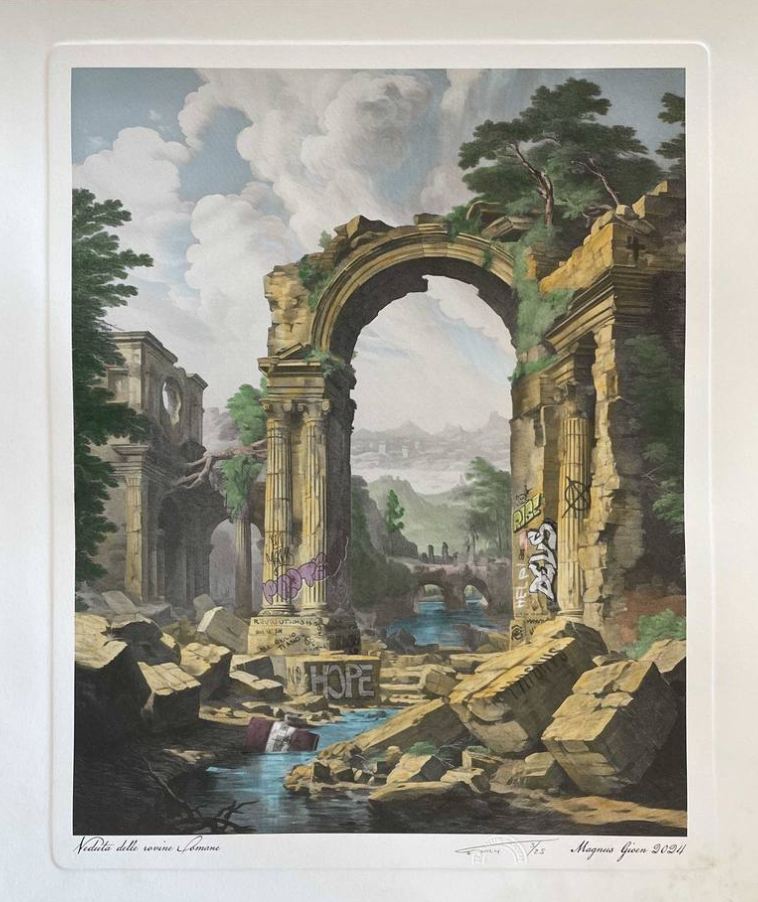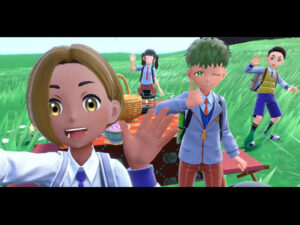Magnus Gjoen, a celebrated artist known for juxtaposing classical art and contemporary techniques, has once again demonstrated his artistic genius with his work Vedut A Delle Rovine Romane. This piece, inspired by the grandeur of Roman ruins and executed with a mix of watercolour, aquatint, and digital engraving, transcends the traditional boundaries of art to evoke a profound dialogue between the past and present.
The Legacy of Roman Ruins in Art
Roman ruins have long inspired artists and architects, symbolizing both the grandeur of antiquity and the fragility of human achievement. During the Renaissance and Romantic periods, ruins became a subject of fascination, depicted in vedute (detailed cityscape paintings) and capricci (fantastical compositions). These works served as memento mori, reminders of the inevitable decay of all human creations, even the mightiest empires.
In Vedut A Delle Rovine Romane, Gjoen embraces this tradition but reframes it within a contemporary context. His use of aquatint, a technique rooted in the 18th century, aligns the work with classical printmaking traditions, while digital engraving disrupts this connection, symbolizing the connect of history and modernity.
A Watercolour Foundation: Subtlety Meets Strength
The watercolour base of Vedut A Delle Rovine Romane is a study in subtlety. Gjoen uses this medium to convey the weathered textures and muted tones of ancient stone. Watercolour, with its translucent layers, reflects the passage of time, as if the ruins themselves are dissolving into history.
Through his meticulous application of washes and tonal gradations, Gjoen achieves an ethereal quality, allowing the viewer to sense the air of antiquity surrounding the ruins. The softness of watercolour contrasts starkly with the boldness of digital engraving, emphasizing the tension between ephemerality and permanence.
Aquatint and the Ghosts of Antiquity
Aquatint, a printmaking technique that creates tonal effects resembling watercolour, adds depth and texture to Gjoen’s work. This method allows him to mimic the granular appearance of stone and the backgrounds casted by crumbling arches and columns. The aquatint process imbues the ruins with a haunting quality, as if ghosts of the past linger within their confines.
Gjoen’s decision to incorporate aquatint reflects his reverence for classical craftsmanship. However, he also disrupts this tradition by introducing digital elements, suggesting that the ruins, while relics of the past, continue to resonate in a digitized world.
Digital Engraving: A Modern Take on Classical Ruins
The most striking element of Vedut A Delle Rovine Romane is Gjoen’s use of digital engraving, a technique that brings precision and a contemporary edge to the composition. The engravings overlay the watercolour and aquatint base, creating a layered effect that invites closer examination.
Digital engraving introduces geometric patterns and fine lines that contrast with the organic shapes of the ruins. This juxtaposition underscores the tension between nature and human intervention, decay and preservation. The digital precision also evokes the way modern technology is used to document and reconstruct ancient sites, bridging the gap between past and future.
Themes of Decay and Preservation
At its core, Vedut A Delle Rovine Romane is a meditation on decay and preservation. The Roman ruins, emblematic of a once-glorious civilization, serve as a metaphor for the transience of human achievement. Yet, through artistic representation, these ruins are preserved and given new life.
Gjoen’s layering of traditional and digital techniques mirrors this duality. While watercolour and aquatint capture the physical decay of the ruins, digital engraving suggests their potential for preservation and reinterpretation in a modern context. This interplay raises questions about the role of art and technology in shaping our understanding of history.
Cultural Significance and Contemporary Resonance
Magnus Gjoen’s work resonates deeply in a world grappling with issues of heritage preservation and technological advancement. As cities modernize and ancient sites face threats from climate change, urban development, and neglect, Vedut A Delle Rovine Romane serves as a poignant reminder of the fragility of cultural heritage.
Furthermore, Gjoen’s use of digital techniques reflects the growing role of technology in art and archaeology. From 3D scanning to virtual reality reconstructions, technology is transforming the way we engage with the past. Gjoen’s artwork, with its digital engravings, embodies this transformation, suggesting that the past and present are not mutually exclusive but rather intertwined.
Magnus Gjoen’s Artistic Philosophy
Magnus Gjoen is known for challenging conventional perceptions of beauty and fragility. His work often juxtaposes the delicate with the destructive, the ancient with the modern. In Vedut A Delle Rovine Romane, this philosophy is evident in the way he blends traditional techniques with digital innovation.
Gjoen’s artistic process is as much about deconstruction as it is about creation. By layering different media, he deconstructs the classical veduta, reconstructing the ruins in a way that reflects contemporary sensibilities. This approach invites viewers to question their own relationship with history and art.
The Viewer’s Experience
Viewing Vedut A Delle Rovine Romane is an immersive experience. The layering of techniques creates a sense of depth, drawing the viewer into the composition. The watercolour evokes an emotional connection to the ruins, while the digital engravings provoke intellectual engagement.
This duality reflects Gjoen’s intention to create art that is both aesthetically pleasing and thought-provoking. The viewer is not a passive observer but an active participant, interpreting the interplay of past and present, decay and preservation.
Impression
Magnus Gjoen’s Vedut A Delle Rovine Romane is a masterful exploration of art, history, and technology. Through his innovative use of watercolour, aquatint, and digital engraving, Gjoen creates a work that is both timeless and contemporary.
The piece serves as a tribute to the enduring legacy of Roman ruins, while also challenging us to reconsider our relationship with the past in a digital age. In blending classical and modern techniques, Gjoen bridges the gap between history and innovation, reminding us that the ruins of yesterday can inspire the art of tomorrow.
No comments yet.








